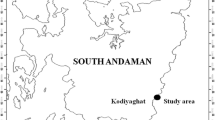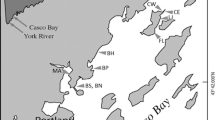Abstract
Ten Spartina alterniflora plants were sampled monthly in a Louisiana estuary to determine the abundance and species composition of stem-dwelling meiofauna and small macrofauna. Most organisms were associated with epiphytic algae found relatively high on standing stems; one harpacticoid copepod, Leptocaris brevicornis, was associated with vascular tissue. Only 15% of the stem fauna was found within 6 cm of the sediment surface. Highest abundance of total meiofauna (>8,000 individuals per 100 cm2 stem surface) occurred in July. The overall seasonal average was 1,563 individuals per 100 cm2 (about 800 per stem). Nematodes (24% of the total) and harpacticoids (adults and copepodites 19%, and nauplii 15%), were abundant and omnipresent taxa. Rotifers (30%) were limited to the summer months, but were extremely abundant when present, 5,037 individuals per 100 cm2 in July. Mites were common (10%) while several groups, for example, amphipods, isopods, polychaetes, and insect larvae, were rare. The stem harpacticoid assemblage was not diverse; four sediment-dwelling and three species reported only from stems were recorded. Overall, abundance was low from December to May, and high from June through November. Winter and spring minima may have resulted from several factors. Estuarine water levels in the Gulf of Mexico are lowered by as much as 25 cm in the winter, and stems likely were desiccated. Highest rhizomatic growth occurs in the spring, and the resulting reduced epiphyte populations may have influenced meiofauna. The density of stem meiofauna above the sediment surface averaged about 225 individuals per 10 cm2 sediment surface, but frequently exceeded that in the surrounding sediments.
Similar content being viewed by others
Literature Cited
Alexander, S. K. 1973. A seasonal study on the microbial flora of Spartina alterniflora Loisel. Ph.D. Dissertation. Louisiana State University, Baton Rouge, Louisiana. 94 p.
Bell, S. S. 1979. Short-and long-term variation in a high marsh meiofauna community. Estuarine and Coastal Marine Science 9:331–350.
Bell, S. S. and L. D. Coen. 1982a. Investigations on epibenthic meiofauna. I. Abundances on and repopulation of the tubecaps of Diopatra cuprea (Polychaeta: Onuphidae) in a subtropical system. Marine Biology 67:303–309.
Bell, S. S., and L. D. Coen. 1982b. Investigations on epibenthic meiofauna. II. Influence of microhabitat and macroalgae on abundance of small invertebrates in Diopatra cuprea (Bosc) (Polychaeta: Onuphidae) tube-caps in Virginia. Journal of Experimental Marine Biology and Ecology 61:175–188.
Bell, S. S., G. R. F. Hicks, and K. Walters. 1988. Active swimming in meiobenthic copepods of seagrass beds: Geographic comparisons of abundances and reproductive characteristics. Marine Biology 98:351–358.
Bell, S. S., K. Walters, and J. C. Kern. 1984. Meiofauna from seagrass habitats: A review and prospectus for future research. Estuaries 7:331–338.
Bell, S. S., M. C. Watzin, and B. C. Coull. 1978. Biogenic structure and its effect on the spatial heterogeneity of meiofauna in a salt marsh. Journal of Experimental Marine Biology and Ecology 35:99–107.
Burke, W. W. 1976. Vertical and horizontal distribution of macroinvertebrates on the cord grass, Spartina alterniflora, in a Louisiana salt marsh. Ph.D. Dissertation. Louisiana State University, Baton Rouge, Louisiana. 116 p.
Chandler, G. T. and J. W. Fleeger. 1983. Meiofaunal colonization of azoic estuarine sediment in Louisiana: Mechanisms of dispersal. Journal of Experimental Marine Biology and Ecology 69:175–188.
Childers, D. L., J. W. Day, Jr., and R. A. Muller. 1990. Relating climatological forcing to coastal water levels in Louisiana estuaries and the potential importance of El Niñosouthern oscillation events. Climate Research 1:31–42.
Coull, B. C. 1990. Are members of the meiofauna food for higher tropic levels? Transactions of the American Microscopical Society 109:233–246.
Coull, B. C., E. L. Creed, R. A. Eskin, P. A. Montagna, M. A. Palmer, and J. B. J. Wells. 1983. Phytal meiofauna from the rocky intertidal at Murrells Inlet, South Carolina. Transactions of the American Microscopical Society 102:308–389.
Coull, B. C. and O. Giere. 1988. The history of meiofaunal research, p. 14–17. In R. P. Higgins and H. Thiel (eds.), Introduction to the Study of Meiofauna. Smithsonian Institution Press, Washington.
Coull, B. C. and J. B. J. Wells. 1983. Refuges from fish predation: Experiments with phytal meiofauna from the New Zealand rocky intertidal. Ecology 64:1599–1609.
Day, J. W., jr., W. G. Smith, P. R. Wagner, and W. C. Stowe. 1973. Community structure and carbon budget of a salt marsh and shallow bay estuarine system in Louisiana, Sea Grant Publ. No. LSU-SG-72-04, Baton Rouge, Louisiana. 80 p.
Decho, A. W. and J. W. Fleeger. 1988. Microscale dispersion of meiobenthic copepods in response to food-resource patchiness. Journal of Experimental Marine Biology and Ecology 118: 229–244.
Feller, R. J., B. C. Coull, and B. T. Hentschel. 1990. Meiobenthic copepods: Tracers of where juvenile Leiostomus xanthurus (Pisces) feed? Canadian Journal of Fisheries and Aquatic Science 47:1913–1919.
Fiers, F. and P. Rutledge. 1990. Harpacticoid copepods associated with Spartina alterniflora culms from the marshes of Cocodrie, Louisiana (Crustacea, Copepoda). Bulletin de L’Institute Royal des Sciences Naturelles de Belgique 60:105–125.
Fleeger, J. W. 1985. Meiofauna densities and copepod community composition in a Louisiana, USA, estuary. Transactions of the American Microscopical Society 104:321–332.
Fleeger, J. W. and G. T. Chandler. 1983. Meiofauna responses to an experimental oil spill in a Louisiana salt marsh. Marine Ecology Progress Series 11:257–264.
Fleeger, J. W., M. A. Palmer, and E. B. Moser. 1990. On the scale of aggregation of meiobenthic copepods on a tidal mudflat. Marine Ecology Pubblicazioni della Stazione Zoologica di Napoli I 11:227–238.
Fleeger, J. W., S. A. Whipple, and L. L. Cook. 1982. Field manipulations of tidal flushing, light exposure and natant macrofauna in a Louisiana salt marsh: Effects on the meiofauna. Journal of Experimental Marine Biology and Ecology 56: 87–100.
Fry, B. 1984. 13C/12C ratios and the trophic importance of algae in Florida Syringodium filiforme seagrass meadows. Marine Biology 79:11–19.
Gee, J. M. 1989. An ecological economic review of meiofauna as food for fish. Zoological Journal of the Linnean Society 96:243–261.
Gibbons, M. J. 1988. The impact of wave exposure on the meiofauna of Gelidium pristoides (Turner) Kuetzing (Gelidi
Author information
Authors and Affiliations
Rights and permissions
About this article
Cite this article
Rutledge, P.A., Fleeger, J.W. Abundance and seasonality of meiofauna, including harpacticoid copepod species, associated with stems of the salt-marsh cord grass, Spartina alterniflora . Estuaries 16, 760–768 (1993). https://doi.org/10.2307/1352434
Issue Date:
DOI: https://doi.org/10.2307/1352434




